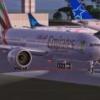
Sign in to follow this
Followers
0

How to blend/merge between paints
By
hsung, in The Paint Shop - The Aircraft Painter's Forum - How To


By
hsung, in The Paint Shop - The Aircraft Painter's Forum - How To